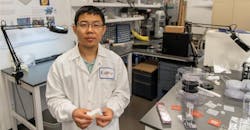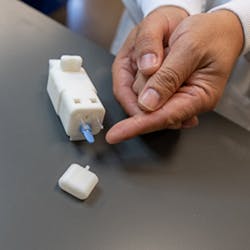Blood Sampler Acts as a Radiation Dosimeter
A research team at the University of Arizona College of Medicine has developed a self-administered blood sampling device that quickly estimates a person’s exposure to radiation in the event of a nuclear accident or attack. Such a device would improve and streamline medical treatment in the event of a radiological or nuclear event. The U.S. Department of Health and Human Services has long sought ways to monitor a population’s radiation exposure following such an event.
“Our research addressed a critical need of sample collection and pre-processing in biodosimetry logistics after a large-scale radiological event for radiation countermeasures,” says Jian Gu, team leader.
Biological dosimetry determines the extent of DNA damage caused by ionizing radiation associated with acute exposure from a dirty bomb or nuclear accident. In ionizing radiation, electrons are knocked off of atoms and form charged particles (ions). In a nuclear event, hundreds of thousands of people would need to be quickly screened, and traditional medical infrastructure for blood collection may not be available.
The fingerstick blood collector is small and highly portable.
The specimens need to be prepared for biodosimetry assays after collection. These assays measure the physical changes in a person’s tissues due to radiation. The team concentrated on collecting and preparing blood to test exposure levels by providing a device that allows a person to collect their own sample that automatically mixes with assay reagents to hasten the process.
Using 3D printing, the team built a device that contained a miniaturized vacuum tube, integrated capillaries, and a lancet fabricated into a self-collection device. It can process the blood specimen for cytogenetic and gene expression biodosimetry that then would be analyzed in a large, centralized bioanalytical lab. Cytogenetic biodosimetry measures the response of circulating blood lymphocytes to accurately estimate the absorbed radiation dose. Gene expression biodosimetry measures the expression levels of a panel of radiation-sensitive genes for the absorbed dose. Results could be returned in one day with the gene expression tests and in three days with the cytogenic tests.
The device was easy to use even for people who never had used a fingerstick blood collector and delivered results similar to samples collected using traditional methods, Gu says. The integrated format avoided the possibility of contamination.
“The collector will alleviate the sample collection bottleneck for radiation countermeasures following a large-scale nuclear event and may be useful in other applications with its self-collection and liquid reagent sample preprocessing capabilities,” Gu concludes.


